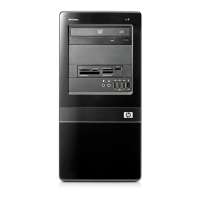Identity In the ProtectTools Credential Manager, a group of credentials and settings that is handled like an
account or profile for a particular user.
Java Card Small piece of hardware, similar in size and shape to a credit card, which stores identifying information
about the owner. Used to authenticate the owner to a computer.
Java Card administrator password Password that links an administrator Java Card with the computer in
Computer Setup for identification at startup or restart. This password can be set manually by the administrator or
randomly generated.
Java Card user password Password that links a user Java Card with the computer in Computer Setup for
identification at startup or restart. This password can be set manually by the administrator or randomly generated.
Low Pin Count (LPC) Defines an interface used by the HP ProtectTools Embedded Security device to connect
with the platform chipset. The bus consists of 4 bits of Address/Data pins, along with a 33Mhz clock and several
control/status pins.
Microsoft Cryptographic API, or CryptoAPI (MSCAPI) An API from Microsoft that provides an interface to the
Windows operating system for cryptographic applications
Migration a task that allows the management, restoration, and transfer of keys and certificates.
Network account Windows user or administrator account, either on a local computer, in a workgroup, or on a
domain.
Personal Secure Drive (PSD) Provides a protected storage area for sensitive data. A feature that is provided
by HP ProtectTools Embedded Security. This application creates a virtual drive on the user's computer that
automatically encrypts files/folders that are moved into the virtual drive.
Power-On Authentication Security feature that requires some form of authentication, such as a Java Card,
security chip, or password, when the computer is turned on.
Public Key Cryptographic Standards (PKCS) Standards generated that govern definition and use of Public
Key/Private Key means of encryption and decryption.
Public Key Infrastructure (PKI) A general term defining the implementation of security systems that use Public
Key/Private Key encryption and decryption
Reboot Process of restarting the computer.
Secure Multipurpose Internet Mail Extensions (S/MIME) A specification for secure electronic messaging
using PKCS. S/MIME offers authentication via digital signatures and privacy via encryption
Single Sign On Feature that stores authentication data and allows you to use the Credential Manager to access
Internet and Windows applications that require password authentication.
Stringent security Security feature in BIOS Configuration that provides enhanced protection for the power-on
and administrator passwords and other forms of Power-On Authentication.
TCG Software Stack (TSS) Provides services to take full advantage of the TPM, but does not require the same
protections. Provides standard software interface for accessing TPM functions. To make full use of TPM
capabilities, such as key backup, key migration, platform authentication and attestation, applications write directly
to the TSS.
Trusted Computing Group (TCG) Industry association set up to promote the concept of a “Trusted PC.” TCG
supersedes TCPA
Trusted Computing Platform Alliance (TCPA) Trusted computing alliance; now superseded by TCG
38 Glossary ENWW

